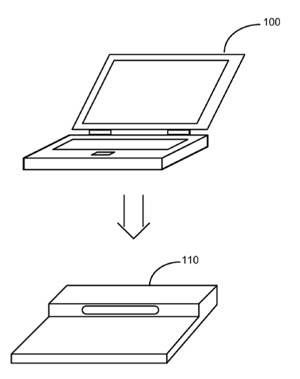An Apple patent (number 20110162035) for a location-based dock for a computing device has appeared at the US Patent & Trademark Office. Designed for Apple laptops, the dock would dynamically change the interface and settings of a portable device for different activities like working or driving a car.
One particular implementation conforming to aspects of the present disclosure takes the form of docking station for a computing device that maintains an indication of a docking station location. The location of the docking station may be utilized by the docking station and/or the computing device coupled to the docking station to configure the functionality and other aspects of the computing device.
For example, the functionality of the computing device may be altered in response to the location of the docking station.
Additionally, security features, display configurations and the availability of software applications may also be configured in response to the location of the docking station. In this manner, a single computing device may perform the functions of several computing devices based on the location of the docking station, without the need for the user of the device to configure the device manually. The inventors are Nicholas Vincent King, Aleksander, and Brett Bilbrey.
Here’s Apple’s background and summary of the invention: “Many portable computing devices, such as notebook or laptop computers, personal digital assistants (PDAs), cell phones, etc. are designed to be lightweight and compact for ease in transportability. However, the compact and lightweight design of such devices often limits the number and types of peripheral devices that are available to the computing device.
“One way to increase the versatility of a portable computing device is couple the computing device to a docking station that provides connections between one or more peripheral devices. A docking station, when connected to a portable computing device, often provides for a number of different types of ports that may not be feasible on a small and lightweight portable device. For example, the docking station may provide one or more ports to drive a large monitor, communicate with various peripherals, provide connection to a network, provide power to the portable device, and so forth.
“Docking stations are typically passive devices, providing straight-through connections to a network and other peripheral devices through a matching interface located on the computing device. Thus, a computing device docked at a docking station located at a user’s home may provide the same functionality when the same device docked at a docking station located at the user’s work office, the only difference being the type and number of peripherals coupled to the docking station at each location.
“Thus, it is often left to the user to configure the computing device for use at different locations by accessing or selecting the proper software applications and security measures for the computing device based on the location of the docking station coupled to the device. However, such configuration of the device may be both time-consuming and confusing to a non-sophisticated user. Thus, what is needed is docking station that determines the location of the docking station, and subsequently the computing device coupled to the docking station, and alters the functionality and configuration of the computing device based on the device’s location.
“One embodiment may take the form of a method for configuring a computing device. The method may include the operations of receiving a location indicator of a docking station coupled to a computing device, selecting a system configuration of the computing device based on the location indicator and altering the functionality of the computing device based on the determined system configuration.
“Another embodiment may take the form of a docking station for a computing device. The docking station may include a processor and a machine-readable medium configured to maintain a location indicator that indicates a location of the docking station. In addition, the docking station may include an interface configured to couple to a computing device to provide the location indicator to the computing device such that the computing device alters the functionality of the computing device in response to the location indicator.
“Yet still another embodiment may take the form of a system for configuring the functionality of a computing device based on a location. The system may include a computing device and docking station configured to communicate with the computing device such that a functionality of the computing device is selected based on a location indicator provided by the docking station to the computing device. ”
— Dennis Sellers

